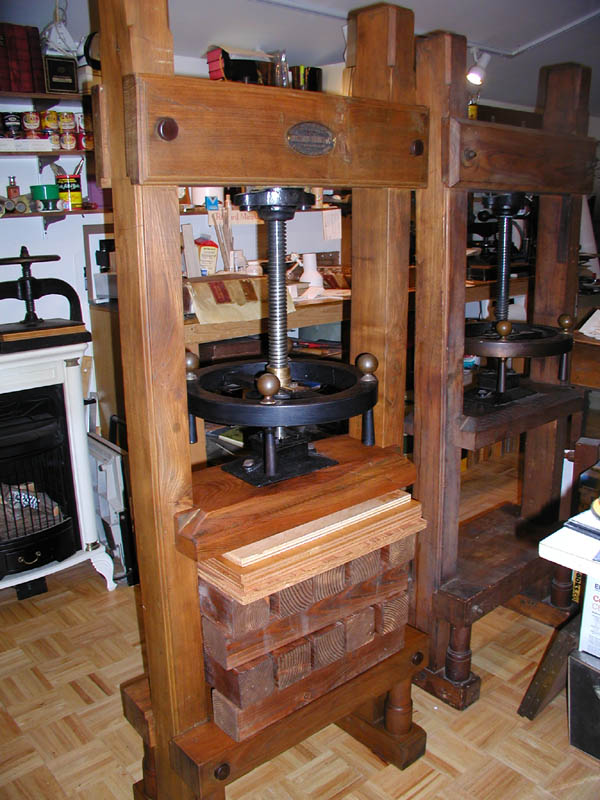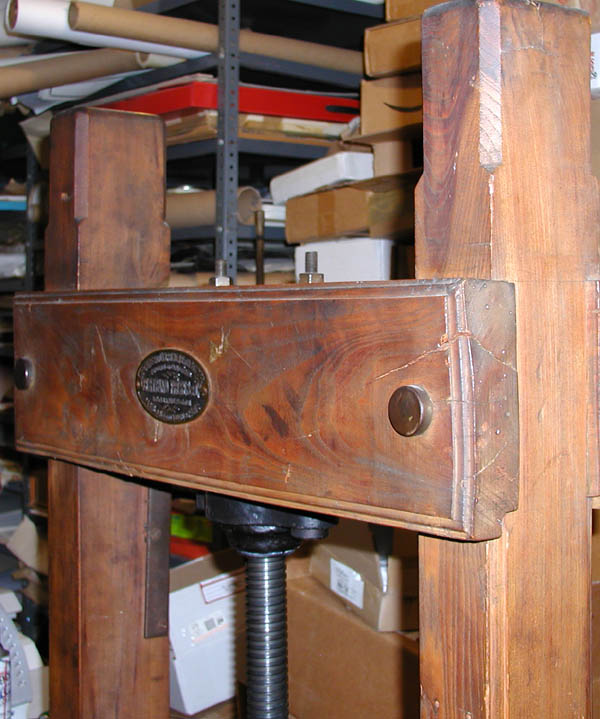The Bertrand Frères Percussion Press
The company of A. Bertrand was founded in Paris in 1871. These presses were made by its successor, Bertrand Frères. The exact date of their manufacture is uncertain, and I have not been able to find further information. The typography on the nameplate is around 1890 in style, but the same plate design may have been used for many years.
The press is on the left in this picture. It stands 6 feet high and opens 28" when the platen is at its highest point. This is called the "daylight" and is the maximum stack of books and boards that will fit.
This press has been in daily use in my studio for decades.
In the above photo the press is filled with wood blocks. I cut pieces of 4x4 cedar to fit and stained them to match the press. Some people prefer to use 6x6 or 8x8 lumber, or bigger. These are not part of the press, but are used to fill the space below the platen when only one book, or a few books, are being pressed. The wood blocks are in rows of long and short blocks. The long ones are 20". They fit between the uprights of the press. The short ones are 16" and are in the alternating rows. The pressing boards in this picture are 16" x 20". In the photo just below, the same blocks and boards are in my other, identical press, which looks brighter because I refinished it.

Refinishing the press (above, left) involved sanding lightly by hand with 150 grit sandpaper and oiling with two coats of Watco Danish Oil. Some checking or cracks were filled with epoxy and painted to match the finish. The screw was cleaned of old grease by spraying it with white lithium grease and pulling a heavy linen cord through the threads. The brass at the base of the threads was stripped of finish and has not yet been coated with anything. I would likely allow it to develop a patina for some time (years) and when the color of the patina is right, apply a light coat of varnish or lacquer. The black painted parts were cleaned and given a light touch up of Rustoleum gloss black oil base paint, then rubbed matte with 0000 steel wool. That matched the old finish. The brass balls have not been cleaned and I am debating about whether to leave them as is or brighten them up a bit.
Below are detail images of the other press, that I did not refinish. Some people prefer the old look. The photos show the checking in the wood. It has been like this as long as I have had the press and none of the checking affects its functioning. It is a sturdy piece of equipment.

Above: The nameplate. The wood seems to be Black Locust, or something similar. It is heavy and very hard.

Above and below: The percussion mechanism. The heavy wheel does not itself tighten or open the press.
It is the piece inside it with the wedge-shaped stops that turns the screw. The brass balls are primarily decorative, though they can be used to turn the wheel. Usually the wheel is turned by the steel handles that descend from it. If the brass balls are used a lot to turn the wheel on these presses, the threads inside them get stripped and should be replaced with steel bushings (available at the local hardware store for about $1). Since I do not use them to turn the wheel, I have left them as is. Once the press is tight to the book, you spin the wheel and it hits the wedge, tightening the press further. This percussion action puts more pressure on the book than can be done turning the wheel by hand.


Above: The feet at the front of the press.

Above: The feet at the back of the press.

Above: The wood at the top of the press is checked, on the right end, but it does not affect the functioning. The checking is above the bolt that attaches the cross-member to the uprights, and is not under pressure when you tighten the press. The pressure on the top member is upward as you tighten. Note the angle iron on the back left of the press. There is one on the back right as well. These were added by a previous owner, and are not original. They could be removed.
Both these presses have screw-holes in the wood near the top, and one also does at the bottom. Likely these were for anchoring it to the floor, cross-beams or ceiling so the press would not spin when high pressure was applied. I do not anchor them, and find that placing my foot against the bottom of the press prevents it from spinning on my polished floor. If it is to be used in production work, rather than fine binding, anchoring would be a good idea to increase efficiency.
To continue the exhibition, click one of the sections or a button.
Each section has several thumbnail images and descriptions of the works. You
can click on any image for a page about that work, with larger pictures and
details.


